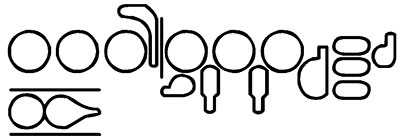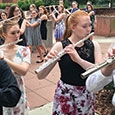If you are hosting a summer masterclass, the curriculum and activities should be varied to ensure good flute-playing health. Playing or sitting too long can be detrimental to an otherwise excellent experience. Alternating activities will enrich the learning experience for flutists of any age or playing level. The following are suggestions for both sedentary and action activities, and some may be more appropriate for one age group than another.
Note Speller
Make some quiz pages where flutists color in the fingering for a specific note or that have fingerings colored in and for student to identify. Include music paper for students to notate notes on the staff. This project is especially good for visual learners.

The Floor Flute
Use a Floor Flute, a giant diagram of the flute keys that is laid out on the floor, to teach fingerings. This is especially good as a group activity because one person is assigned to each key. The diagram can be made out of canvas or can be constructed with tape on the floor. This activity is equally beneficial to young flutists who are learning fingerings for the first time and for older flutists who are trying to improve coordination. Practicing tricky fingerings such as the top octave F# to G# as a group enhances the coordination of the fingers when doing it individually on the instrument. Other games such as playing scales and simple melodies are listed in the article. (
.jpg)
Theory Pages
Create a packet of pages that will take several class periods to complete. Contents might include: how to draw a treble clef, draw the time signature, notate the sharps or flats in order, use the circle of fifths, write major and three forms of minor scales, write an ascending and descending chromatic scale, write scales in thirds, fourths, fifths, and octaves, and illustrate the direction of the stem in writing music. Other topics might include the rules of the natural sign, interval instruction and identification (rule of 9: fourths invert to fifths, thirds invert to sixths etc.), how to place the bar lines into a string of notes in 2/4, 3/4, or 4/4, and a study of simple and compound time. For advanced students, the pages could encompass fingerings for extended techniques and mixed meters. For mixed meters, practicing conducting will improve performance. Use a mirror to be sure students are articulate in the conducting gestures. Once completed, the packets can be taken home as a resource.
Dynamic Dictation
College students always complain about taking dictation. In fact, they have complained so much that most schools have lowered their expectations on taking harmonic dictation. When I was at conservatory, we took down all four parts. Now most schools only expect students to write the soprano and bass line. Students do not like taking diction because it is a challenge for most. However, those who can do it well turn out to be the most successful chamber and orchestral players. To play well in an ensemble, you have to know what others are playing. Score study can help this as can dictation practice. Score practice utilizes the eyes while dictation improves the ears.
Diction practice can done in several ways. The first exercise works on articulation. The flutist who is the soloist plays an excerpt with the written articulation. Other flutists in the audience are given the excerpt only, with all of the articulation marks whited out. As the flutist plays, the others write the articulation they hear. Then the pages are collected and given to the soloist. This allows the player to see if the intended articulations were projected well. For younger students use a scale that utilizes one of the basic articulation marks: slur, staccato, marcato, tenuto, or accent. With practice, students should be able to mark in the articulation (slurs and articulation marks) for an eight-bar melody.
Another variation on this exercise uses dynamics. A flutist plays an excerpt according to the printed dynamics. The audience members have a copy of the excerpt without the dynamics, and each person fills them in while the soloist plays. This is often a wake-up call to the flutist to do more with the dynamics. Variations of this could examine tempo, with each audience member charting where the soloist deviated from a printed tempo.
Anatomy Study
The more students know about anatomy and how the body works the safer their playing will be. There are anatomy coloring books that have been created for medical school instruction for nurses, doctors and physical therapists. The pages are designed to be copied and then colored in by students. Templates of the head, mouth, throat, shoulders, arms, fingers, and wrists are good areas to explore.
Make a Flute
There are several kits available online for making ethnic flutes. Some are come already glued while others are not. Most kits can be completed in a few sessions. The better kits come with detailed instructions on gluing, sanding, painting, and decorating. There are several that even include a fingering chart and some melodies to play. This is a fun activity for all ages and is a good introduction to the world of wooden flutes.
Juggling
If you can find someone to teach students to juggle, it is worth the person’s fee. To juggle successfully, one has to learn to count and wait. If you do something before the beat, then you will drop the juggling ball. Several students of mine learned to juggle so well that they could do it in pairs.
Dancing
If you live in an area where there is access to a historical dancing group, see if the group could teach your students Baroque dances. Knowing the movements will certainly improve how they play these dances. If this is not an option, there are excellent instructional videos on YouTube that could be watched and acted out. Often ballet teachers have some experience with the period dances and might be willing to do the research to help you teach Baroque dances. Dancing involves the whole body and is a great device for improving rhythm. It is also fun and can be used as a social activity.
Learn Something in Unison
For several years I had everyone in the flute camp learn four Barret melodies (Barret, 40 Melodies for Oboe, Boosey & Hawkes, Nos. 1, 2, 4 and 5). These were taught in the intermediate and advanced classes and on the final concert, everyone played them together in unison. The first time Michel Debost was teaching with me, I wondered what he would think of such an event. Afterwards he told me it was genius because during those pieces the flutists listened better than they did for anything else on the concert. Having to play something exactly like everyone else is what musicians have to do in tutti passages in ensembles.
Pick a Letter
Select a letter and ask students, taking turns, to come up with as many words as they can that begin with this letter. Each word should relate to music in some way. As students say a word, they also explain how this word will be useful to a musician. Write down the list as you go along and ask students to think about these words as they play that day.
Practice
Perfection
Patience
Perseverance
Punctuality
Politeness
Piano
Pacing
Planner
Painting
Presentation
Patina
Pear or Pearl
Pulse
Performance
One of my favorite books is Master Teacher: Nadia Boulanger by Don Campbell. In the middle of the book are quotations from her teachings that are shared by students. While most of these were written with the composer in mind, her advice is excellent for instrumentalists as well. Select an interesting quote for a rich topic of group discussion.
If your program focuses on younger students, activity events should change more rapidly than they would with older students. Be prepared with many options. We would love to hear from you. Send your curriculum enrichment ideas to share with other readers to
editor@flutetalkmagazine.com






